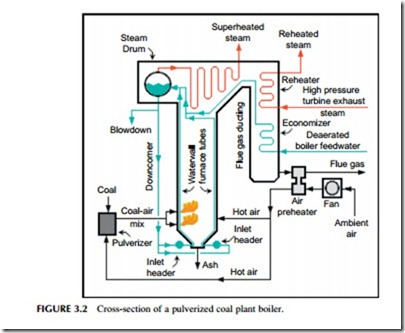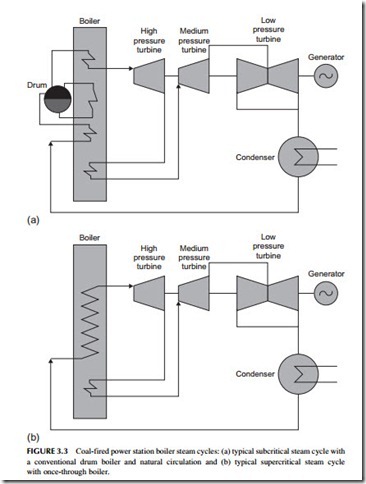BOILER TECHNOLOGY
The boiler in a coal-fired power plant converts chemical energy contained within the coal into heat energy that is captured and carried away in hot, high-pressure steam (Figure 3.2). Coal-burning technology has a long history and has seen many plant configurations, but the most important type of plant in modern use is the pulverized coal-fired power plant, often abbreviated as PC plant. PC plants probably account for more than 90% of all operating coal-fired power stations in general use and this type of plant is the main plant design for future high-efficiency coal-fired plants.
A PC plant burns coal that has first been ground to a fine powder using large grinding mills. A typical plant will have several of these, each feeding a single
burner. These burners are where the coal, mixed with air, is injected into the boiler where it ignites in a high-temperature fireball inside the furnace, consuming the fuel and releasing chemical energy as heat.2 Several burners are used to create a stable fireball in the center of the furnace where combustion takes place. The temperature within the fireball may reach 1500–1700 oC in the hot- test part of the flame. At these temperatures the nitrogen in air is easily oxidized to produce nitrogen oxide. To keep nitrogen oxide production at a minimum, the amount of air entering the combustion chamber with the pulverized coal is restricted, maintaining a chemically reducing atmosphere in which virtually all the oxygen is captured during carbon combustion, leaving none to react with nitrogen. Additional air is then introduced higher up the combustion chamber to complete the coal combustion process, at a point where the temperature of the combustion gases has lowered and the reaction of oxygen with nitrogen proceeds more slowly.
The heat released during combustion is partly radiant heat and partly convective heat. Radiant heat is captured by water running in tubes within the walls of the combustion chamber. Further collections of tubes are placed in the path of the flue gases exiting the combustion chamber, and as water passes from one set of tubes to another its temperature rises and finally steam is generated (Figure 3.3). In a conventional boiler this will take place within a steam drum, which allows the phase change between liquid and gas to proceed smoothly. Steam from the drum may then be superheated to create an even higher-temperature gas.
In the most modern plants the temperature and pressure within the boiler tubes is such that water enters a supercritical state under which the distinction between liquid and gaseous states cease to exist. With this type of plant a steam drum is not necessary. Units of this sort are called supercritical boilers, while those with steam drums are called subcritical boilers. Supercritical boilers are capable of producing steam at much higher temperatures and pressures than subcritical boilers, therefore steam turbines fed from such plants are capable of higher Carnot cycle efficiency.
The supercritical point for water occurs at 22.1 MPa/374.1 oC. So long water remains above the supercritical point and within its supercritical phase there is no longer a need for a drum in a power plant steam system to allow the water to boil. Instead the conversion from water to steam can occur homogenously within the boiler pipes as the temperature rises.
Steam conditions at the exit of a modern subcritical power plant boiler vary widely but typical figures would be a steam temperature of 540 oC and a steam pressure of 17.5 MPa. Such a plant would be capable of generating power at an efficiency of around 38%, depending on site conditions. Supercritical power plants operate at steam exit temperatures of 540–600 oC and at exit pressures of 23–30 MPa. These plants can achieve efficiencies up to 41%. There is a
further subdivision called ultra-supercritical power plants that operate at even higher temperatures and pressures. Although the definition of ultra-supercritical is not precise,3 plants operating at these more extreme conditions have been capable of up to 45% efficiency under optimum site conditions. In comparison, the average efficiency of coal-fired plants operating across the globe is around 28% and that of the U.S. coal fleet is around 33%.
The extreme temperatures and pressures in supercritical boilers make extreme demands on the materials used to construct them. While steam boilers have traditionally been constructed from steels, conditions in ultra- supercritical power plants require that some components are made from nickel-based alloys similar to those used to construct the high-temperature components used in gas turbines. These materials are more costly than steels. With further materials development it is expected that future plants will be able to operate at steam temperatures of 700–750 oC. This should permit an energy- to-electrical conversion efficiency as high as 55% to be achieved in a coal-fired steam plant.
While efficiency is the most important factor driving boiler design, flexibility has also been recognized as vital in recent years. Coal-fired power plants have traditionally operated as base-load power stations operating essentially at full output all the time. This is no longer the situation everywhere. In some regions coal-fired power stations are being used to support the generation of renewable electricity. This means they have to be able to operate both efficiently and effectively at part load as well as full load, and to be able to change output load as required by the grid. One technique being used to achieve this is sliding-pressure operation under which the steam pressure is allowed to fall as output falls but steam temperature is maintained. With sliding-load operation it is possible to maintain relatively high efficiency at part load, even though this may involve falling below the critical point of water.

